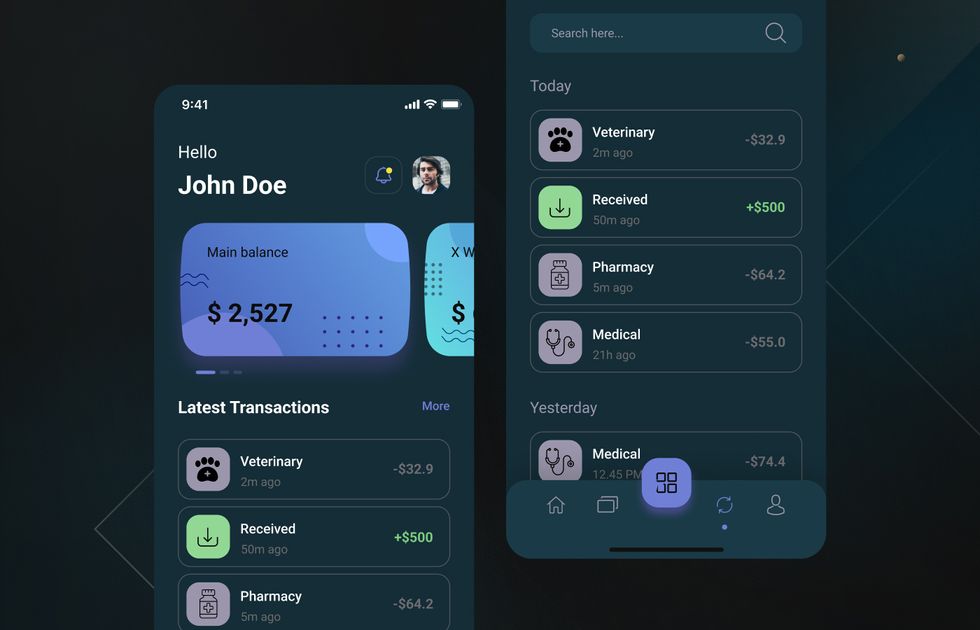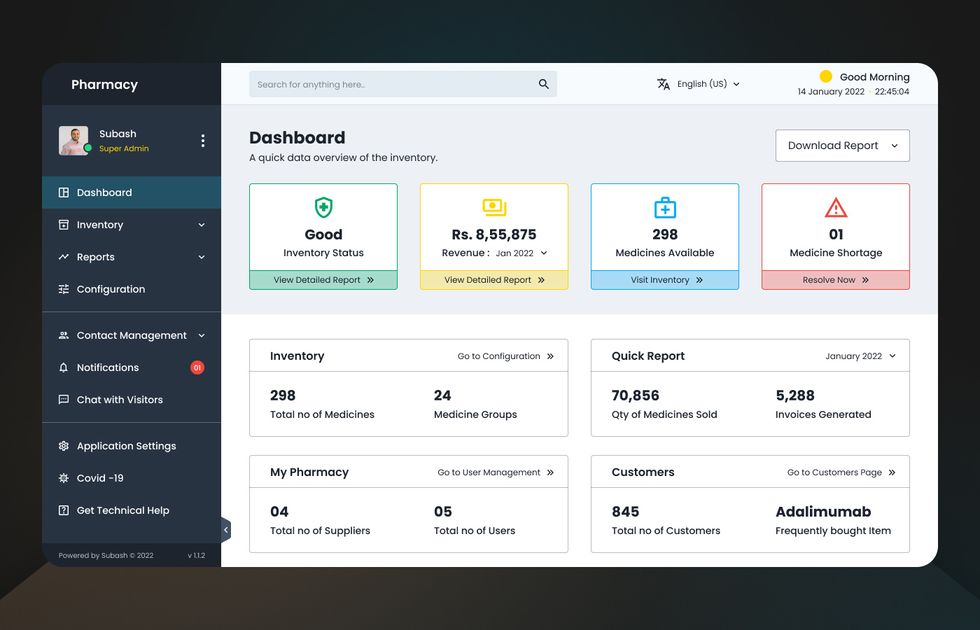
Key Takeaways
- SaaS medical software is a cloud-based application that can be accessed over the Internet without the need for on-site installation or infrastructure management.
- It provides healthcare organizations with accessible, scalable, cost-efficient, secure, integrated, and regularly updated solutions.
- Healthcare SaaS offers features like electronic health records (EHR), practice management, patient scheduling, billing, telemedicine, and patient engagement tools.
Healthcare companies want technology to assist their medical personnel and improve the quality of patient care. However, outdated software often complicates their workflow. In this case, we recommend developing a healthcare SaaS software that will be tailored to your needs.
In this article, we will explain why SaaS is expected to be the most popular cloud model in this market. We’ll also tell you how building a SaaS platform benefits healthcare providers, how to move your old infrastructure to the cloud, and what features will enhance your facility. Make sure to read until the end to learn about technical and legal difficulties you may face during SaaS healthcare software development.
SAAS Healthcare Market Size
The global healthcare SaaS market grew from $18.33 billion in 2022 to $21.56 billion in 2023 and is expected to reach $42.13 billion by 2027, with a CAGR of 18.2%.

The healthcare SaaS market is developing rapidly due to tech advancements and cloud adoption. For example, leading companies are integrating next-gen SaaS technologies like AI, Vertical SaaS, Pay-Per-Use Models, IoT, and system integration. Cloud computing also drives market growth by enhancing data security, scalability, flexibility, and cost savings.
What Is a SAAS Healthcare Software
Software as a service (SaaS) is a cloud-based delivery model that allows hosting and deploying applications on third-party infrastructures. For example, your healthcare software applications are hosted on the cloud and delivered online.
This allows healthcare organizations to access and use software applications via web browsers rather than installing and maintaining them on local servers or computers. At the same time, they pay for the service through a subscription model.
SaaS in healthcare centralizes patient records and clinical data, providing a platform for efficient collection, storage, and retrieval. It supports telemedicine by enabling remote consultations, video conferencing, and virtual health visits. SaaS also manages Electronic Health Records (EHR), offering real-time access to patient data and treatment histories.
Advantages of Building a Healthcare SaaS for Hospitals

Healthcare facilities are quickly moving toward cloud-based solutions due to:
- Cost efficiency
- Scalability
- Accessibility
- Compliance and security
- Resource-effective management
Let’s discuss them in more detail.
Cost Efficiency
Building a healthcare SaaS solution cuts app development costs by replacing upfront investments with a pay-as-you-go model. Subscriptions cover usage, not hardware or software licenses, easing budget management. Additionally, SaaS providers handle maintenance, updates, and security, reducing hospitals’ operational expenses and IT burdens.
Scalability
Healthcare SaaS platforms scale seamlessly with hospital needs, adapting to patient volume and service expansions. This flexibility supports day-to-day operations and accommodates surges in demand, like during health crises, without requiring extra hardware or extensive reconfiguration. That means hospitals can grow their services and facilities without IT system constraints.
Accessibility
Healthcare professionals securely access software from any device with the internet, whether on-site, remote, or in telemedicine consultations, where doctors can consult with patients online. Enhanced accessibility improves collaboration among healthcare teams and speeds up decision-making processes, leading to better patient outcomes.
Compliance and Security
SaaS providers typically offer robust security measures and are well-versed in healthcare regulations like HIPAA. They implement advanced encryption, regular security updates, and stringent access controls to protect sensitive patient data. As a result, hospitals can ensure that their software meets legal and regulatory requirements without extra investment.
Resource-Effective Management
Healthcare SaaS solutions streamline hospital resource management by automating administrative and clinical workflows. They enable efficient staff scheduling, allocation of hospital beds, and medical equipment coordination. Data analytics offer insights into resource utilization, while predictive analytics forecast patient admissions.
Features of Custom Medical SaaS Platforms

The features below will turn your SaaS platform into a valuable solution for patients and medical personnel.
Document Management
Healthcare facilities should implement a module for managing medical records and other important files, allowing for:
- Uploading multiple files in batches
- Automatic text filling
- Natural language processing (text and voice recognition for prescription processing and - health data entry)
- Ability to upload documents for patients
- Clinical document templates
- Support for multiple file sizes and formats, including image and video files
- Automatic image and video format conversion
EHR Integration
Integrating your EHR with a SaaS platform enables swift access, sharing, and management of patient health information, facilitating the exchange of videos and images to enhance diagnostic accuracy.
At the same time, health information exchange (HIE) streamlines medical data transfer among clinics and organizations. A clinical decision support system (CDSS) analyzes EHR and EMR data to offer diagnosis and treatment suggestions.
Telehealth

Telemedicine (video-conferencing) is one of the fastest-growing healthcare technology trends. Studies indicate that the pandemic made 75% of Americans more willing to try virtual care. Nearly half (45%) of adults surveyed have used telehealth services at least once, with a significantly higher usage rate (61%) among adults aged 18 to 34.
A video conferencing module in your SaaS can help doctors:
- Examine symptoms, wounds, respiratory efforts, and other signs remotely
- Make diagnoses and prescribe medication
- Follow the treatment progress and check the results
Scheduling and Notifications
Scheduling tools will allow your doctors and patients to book and move appointments inside the app. Reports suggest that 48% of adults have used online/mobile self-scheduling to book medical appointments in the last year, indicating widespread adoption. At the same time, 11% of healthcare consumers surveyed noted their provider lacks online scheduling options.
If you want to ensure that visitors don’t forget about their visits, consider email, text, and push notification reminders. Also, integrate your platform with calendar apps and hospital management software.
Administrative Tools
An administrative module for your healthcare platform will help run your facilities and keep an eye on business performance with tools for:
- Medical staff performance monitoring
- Finance and accounting
- Inventory and pharmacy information control
- License and subscription management
- Patient information monitoring (lifetime value, churn, acquisition cost, recurring revenue)
- Targeted marketing (email campaigns, product offerings, discounts)
Digital Payments and Billing

A billing module is critical for a SaaS solution if you want your staff to spend less time on redundant tasks. Be sure to include:
- Automated invoicing and tax management
- Billing management features
- Metrics for expenses and revenue (for individual clients, client groups, and hospitals)
- Payment failure and refund handling
- Multi-currency support and multiple payment methods
- Special offers and discount management
- Checking for insurance coverage and reimbursement for healthcare services
Data Analytics and Reporting

You need a software module to analyze the activity and performance of your SaaS product:
- Used memory and storage (per facility, user group, and individual)
- Devices used to access the platform
- Bandwidth costs (per facility, user group, and individual)
- Periods of increased and reduced activity
- System uptime
Patient Support Portal
Self-service remains a favored tool, benefiting service organizations seeking cost savings and customers seeking swift resolutions. A significant share (59%) of patients prefer using self-service tools for addressing simple questions and issues.
This means you should include it in healthcare SaaS solutions, allowing patients to manage bills, schedule appointments, and upload data from their app.
Compliance Management
A compliance management module can help ensure that your software and activities align with data security laws and practices. The model usually includes:
- Audit management for investigating law compliance issues (HIPAA, GRPR, UK-GDPR, PCI DSS) and security standards (ISO 27001 and 27002)
- Scheduled reports on performance indicators for sensitive business processes
- Fraudulent activity detection for payments and financial statements
- Compliance and security training for medical staff and IT departments
How to Move Your Healthcare Product to the SaaS Model

You need to consider a plethora of factors when shifting your workflows to the SaaS model. The process involves multiple stages, starting from an in-depth audit of your current platform.
1. Analyze Your IT Infrastructure
Your main points of attention during the analysis should include:
- Goals of SaaS medical software development for key stakeholders
- Primary patient categories (demographics, age, medical conditions)
- Local government regulations and certification procedures
- Current usage of storage and compute resources (CPU and RAM)
- Interoperability capabilities of your electronic health record (EHR) and management systems
- Business and operational support services to integrate into the SaaS platform
- Software modules to add to your healthcare software
- Workflows to discard (productivity bottlenecks)
- Personal health information (PHI) your collect, store, and share
- Data management and backup policies and procedures
- Security and privacy protection mechanisms
By the end of the assessment, you should define the project’s overall scope, budget, and timeframes. The web development team has to document all technical requirements and collect stakeholders’ approval.
2. Choose the Optimal SaaS Architecture
After learning modern architecture best practices and gathering technical specifications, you need to select a cloud microservices architecture based on the required resources and data isolation. Your options include single-tenant and multi-tenant SaaS:
- Single-tenant SaaS architecture isolates your application, database, and supporting infrastructure from other users. This means fewer security vulnerabilities and a customizable environment with separate computing resources. However, this model won’t let you easily scale your resources once you identify inefficiencies.
- Multi-tenant SaaS architectures isolate your data, but you have to share software instances, computing resources, and datasets with other users. You get to use a complex and scalable infrastructure, which is also maintained by the provider.
3. Select a Cloud Service Provider
Certified cloud computing platforms like AWS, Microsoft Azure, and Oracle Cloud provide SaaS infrastructures for healthcare organizations. They also offer out-of-the-box tools to help you automate processes, analyze data, and ensure regulatory compliance.
Most medical SaaS companies have multi-tenancy and single-tenancy architectures and flexible service packages for all types of healthcare companies.
4. Set Up an Authorization Server
An authorization server takes care of resource-heavy processes that happen every time someone tries to access your SaaS platform. The server must check credentials, affiliation, and process additional authentication mechanisms before granting an access token. This might happen hundreds or thousands of times a minute. So, it’s advisable to reduce the burden on your server with third-party rights management tools.
5. Develop an MVP
We recommend creating a minimal viable product (MVP) with essential functionality before building the full version of the platform. It helps gather feedback from your stakeholders, doctors, and real clients much faster, giving you more time to alter and adapt the system. After refining the core elements of your platform, you can add secondary features.
Technologies Needed to Develop a Healthcare SaaS Solution
The technologies you’ll need depend on the functionality and use cases of the SaaS healthcare product you want to build. But from our experience, this is the optimal SaaS tech stack with programming languages and backend frameworks:
- Python — a dynamic object-based programming language for scalable SaaS applications and data analytics systems
- React — a frontend library with robust DOM-manipulation tools and a big ecosystem of compatible frameworks and libraries to build rich web user interfaces
- React Native — a framework that allows developing mobile apps using React and JavaScript almost like web apps
- Node.js — a JavaScript runtime that helps build scalable apps with interruption-free concurrent connections between doctors and patients
- webRTC — technology for real-time peer-to-peer communications and video streaming
At the same time, you can always simplify development by using the backend as a service or function as a service.
Challenges of Developing Healthcare SaaS Platforms
Developing healthcare software is particularly complex due to the specifics of SaaS in the medical industry. Here are some of the issues you should pay special attention to.
Data Security
In 2023, healthcare breaches reached an unprecedented high, surging to 133,068,542 breached records – 156% compared to the previous year. This figure surpassed the previous record of 113 million set in 2015. On average, 373,788 healthcare records were breached daily throughout the year.

- Hackers accessed an external storage location used for email formatting, compromising 11,270,000 records at HCA Healthcare in Tennessee.
- PharMerica Corporation experienced a ransomware attack, which resulted in a data leak affecting 5,815,591 records. The attack was attributed to the Money Message ransomware group.
- A telehealth company, Cerebral Inc., faced an impermissible disclosure of PHI (Protected Health Information) through a Pixel tracking code on its website, affecting 3,179,835 records.
You should focus on security, implementing multi-factor authentication, access control, encryption and tokenization, log monitoring and intrusion detection tools, and data backup and recovery plans.
Regulatory Compliance
The Office for Civil Rights at HHS intensified HIPAA enforcement in 2023, securing seven settlements totaling over $1.9 million for privacy and security violations in healthcare. The FTC prioritized health data privacy by enforcing its breach notification rule and issuing refunds to affected consumers from four companies.
Ensure your software and policies adhere to HIPAA Privacy and Security rules. At the same time, be ready that the Federal Food, Drug, and Cosmetic Act (FFDCA) regulates the use of medical devices.
Interoperability and Standardization
Health information exchanges (HIEs) help medical providers maintain a competitive advantage in their market (60%), reduce administrative costs associated with EHR data retrieval (55%), and avoid penalties because of information blocking (50%).
However, healthcare organizations have difficulties even moving data between software modules due to interoperability issues. Health SaaS companies can prevent such issues by adopting Fast Healthcare Interoperability Resources (FHIR) — an industry-accepted standard for effectively exchanging medical records.
Acropolium’s Expertise
A seasoned medical software developer understands what healthcare companies need (from chatbots to IoT solutions) and can help you build a SaaS product that provides real value to doctors, nurses, and patients.
Acropolium has done dozens of migrations (as well as software reengineering projects) and built many successful healthcare and fintech SaaS solutions. We can help your SaaS healthcare company develop custom software and support your migration to SaaS with minimal operational disturbances. Plus, our experts can pick the appropriate technology stack, provider, and security mechanisms for your needs.
What about healthcare SaaS examples? Our client, the US healthcare clinic, has adopted an advanced SaaS solution for appointment booking, integrating medical scheduling with electronic health records (EHR). This upgrade has significantly reduced patient no-shows by 30%, cut wait times by 25%, and increased patient access to medical records by 40%.

Final Thoughts
The SaaS cloud computing model offers a lower cost of ownership, limited initial capital expenses, and less infrastructure maintenance. Migrating your platform to the cloud can streamline data exchange and increase the performance of your software, enhancing the quality of patient care.
However, developing healthcare SaaS software solutions isn’t easy. Even with our migration guide, you can encounter technical, regulatory, or security challenges. That’s why it’s helpful to have a skilled partner by your side. Get in touch with our dedicated team so we can talk about IT outsourcing.









![SaaS ERP vs Cloud ERP: [Which Works Best for You?]](/img/articles/saas-erp-vs-cloud-erp/img01.jpg)


![SaaS Migration Strategy: [Why Move to SaaS and How to Do It]](/img/articles/saas-business-model/img01.jpg)
![ᐉ SaaS Application Development [2025 Guide]](/img/articles/saas-application-development-2022/img01.jpg)
![How to Build a SaaS MVP [2025 Step-by-Step Guide]](/img/articles/build-saas-mvp/img01.jpg)